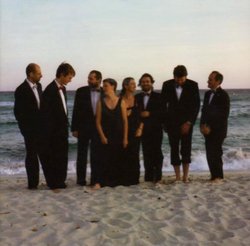| All Artists: Claudio Monteverdi, Claudio Cavina, La Venexiana Title: La Venexiana Live!: Madrigals by Claudio Monteverdi Members Wishing: 0 Total Copies: 0 Label: Glossa Release Date: 10/21/2003 Album Type: Import, Live Genres: Pop, Classical Styles: Vocal Pop, Opera & Classical Vocal, Chamber Music, Historical Periods, Baroque (c.1600-1750), Classical (c.1770-1830) Number of Discs: 1 SwapaCD Credits: 1 UPCs: 675754666927, 8424562309128 |
Search - Claudio Monteverdi, Claudio Cavina, La Venexiana :: La Venexiana Live!: Madrigals by Claudio Monteverdi
 | Claudio Monteverdi, Claudio Cavina, La Venexiana La Venexiana Live!: Madrigals by Claudio Monteverdi Genres: Pop, Classical
|
Larger Image |
CD Details |
CD ReviewsNew and old style opening the future & reflecting the past Jacques COULARDEAU | OLLIERGUES France | 11/23/2006 (5 out of 5 stars) "Polyphony went through a total revolution with Monteverdi who represents the continuation of the older style, essentially religious and sacred, while he invents the new style that eventually got banned by Rome, the Pope, and had to exist exclusively in secular music, madrigals and later operas. The change is capital because in the old style variations and at times the assemblage of the various voices were dictated by know-how, i.e. tradition, and any tradition is conservative. Monteverdi gets rid of these limitations in his new style. He thus uses instruments in a new way, i.e. no longer as a simple continuous accompaniment to keep the voice set right on this instrumental background, but as a musical composition in itself. It is quite clear in this CD with the use of the harpsychord for example. The second change is of course the syntax of the voices that is also freed to satisfy artistic requirements and innovative new attempts, instead of keeping the simple use of voices to create an atmosphere of worship or contemplation, of solace or contrition. The old style is there only to help the faithful get in the right mood to get in touch with the divine. That music tries to create a unified vision of divine harmony bringing together opposed elements like voices, or particular sets of intervals with one of those rejected as diabolical and supposedly unharmonious and thus undivine, the infamous tritone or diminished fifth. The new style enables Monteverdi to work on the attempt to create beauty, to create a music that evokes pleasure, both spiritual and sensual, in the listeners. The old style has a conception of beauty that is not in the music itself but in the divine and the music is supposed to reflect that beauty to hoist the faithful onto the shoulders of the musicians in their search for God. The new style attempts to create beauty in the music itself. Some pretend the Renaissance invented beauty. This is absurd. The Renaissance changed our conception of beauty, or rather in the 15th century our conception of beauty changed and it is this change that produced the Renaissance. In this CD the madrigals are the perfect illustration, a deeply joyful and pleasurable illustration, of this new conception of musical beauty. And it is so perfect that we feel the world has stopped living, the earth turning, the sun and the stars shining and twinkling. This conception of beauty arrests the mind. It brings you into a feeling that is close to coming, coming home to absolute, blind, insane blissful pleasure. But this CD, like the music it contains, goes beyond. Listen to the seventh piece, « Ardo e scoprir », and you'll find there is another dimension in this music, a dramatic dimension, maybe even tragic. In the old style the antagons were in God's creation and the music tried to reflect the divine beauty of the divine equilibrium of the creation. Here the antagons are in the voices, the singing, the music itself, and the clash between them becomes drama and of course reflects Monteverdi's practice of the opera : music becomes a medium that carries the drama, the tragedy, the conflict, the unbalance, the chasm, and it is the music that has to create, recreate, reconstruct some dramatic balanced outcome. And beauty is then both in the dramatic clash and in the eventual balance that will come out of the musical treatment of the conflict. We are reaching here a new level of total artistic apprehension of the world. And this new totality brings another pleasure embodied in the deep human desire to create harmony out of a struggling conflictual reality splintered into legions of shattereens and withereens. This dimension of beauty is extremely modern even if today we tend to think there is no way to invent, design or even conceive such a rediscovered equilibrium and unity. And we can feel at times this breath of modernity that makes the unified endings sound and feel artificial, like the final unison of the ninth piece, « Addio Florida Bella ». And the use of the countertenor in contrast to the tenor and the bass is absolutely sublime in the impossible melting of these three male voices, in the thirteenth piece, « Gira il nemico insidioso », even in death itself.
Dr Jacques COULARDEAU, University of Paris Dauphine & University of Paris 1 Pantheon Sorbonne " |

 Track Listings (15) - Disc #1
Track Listings (15) - Disc #1